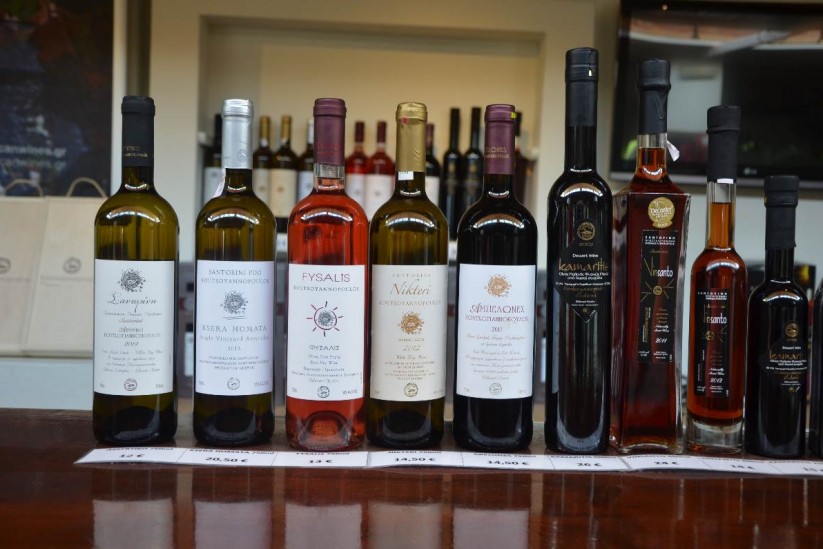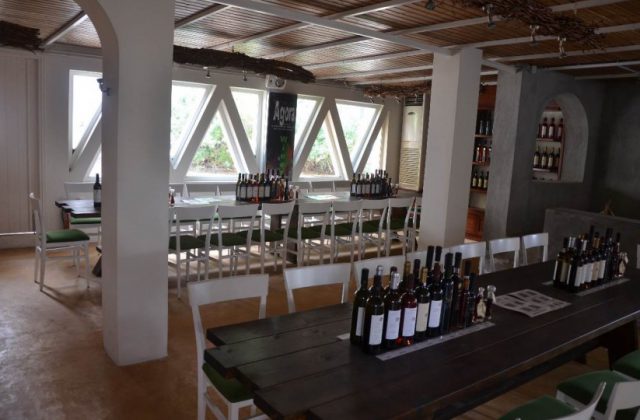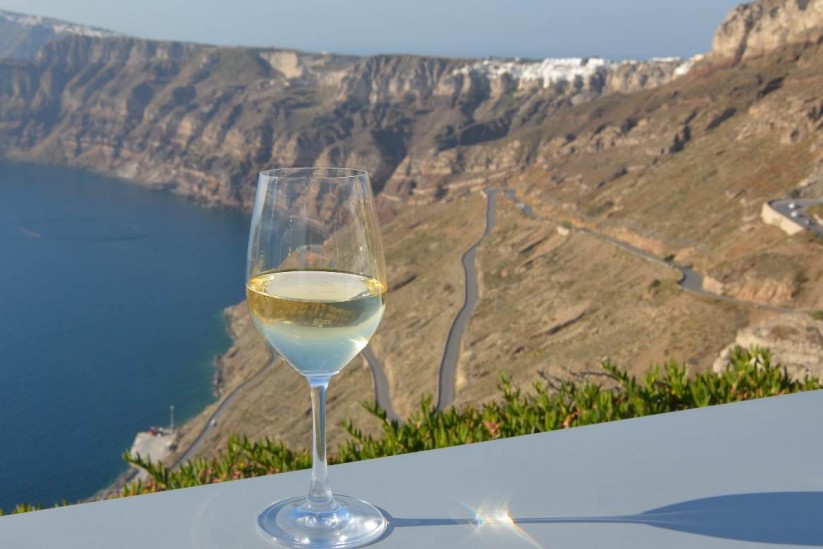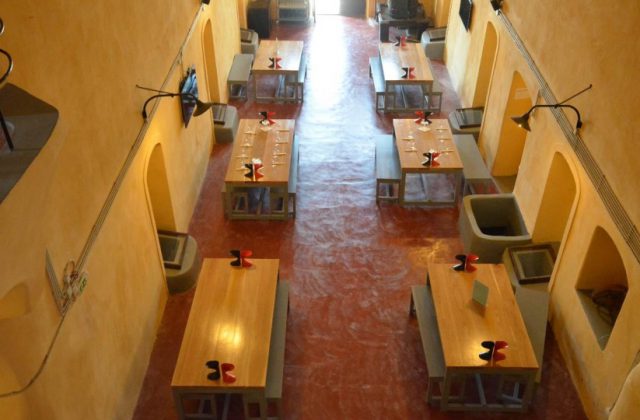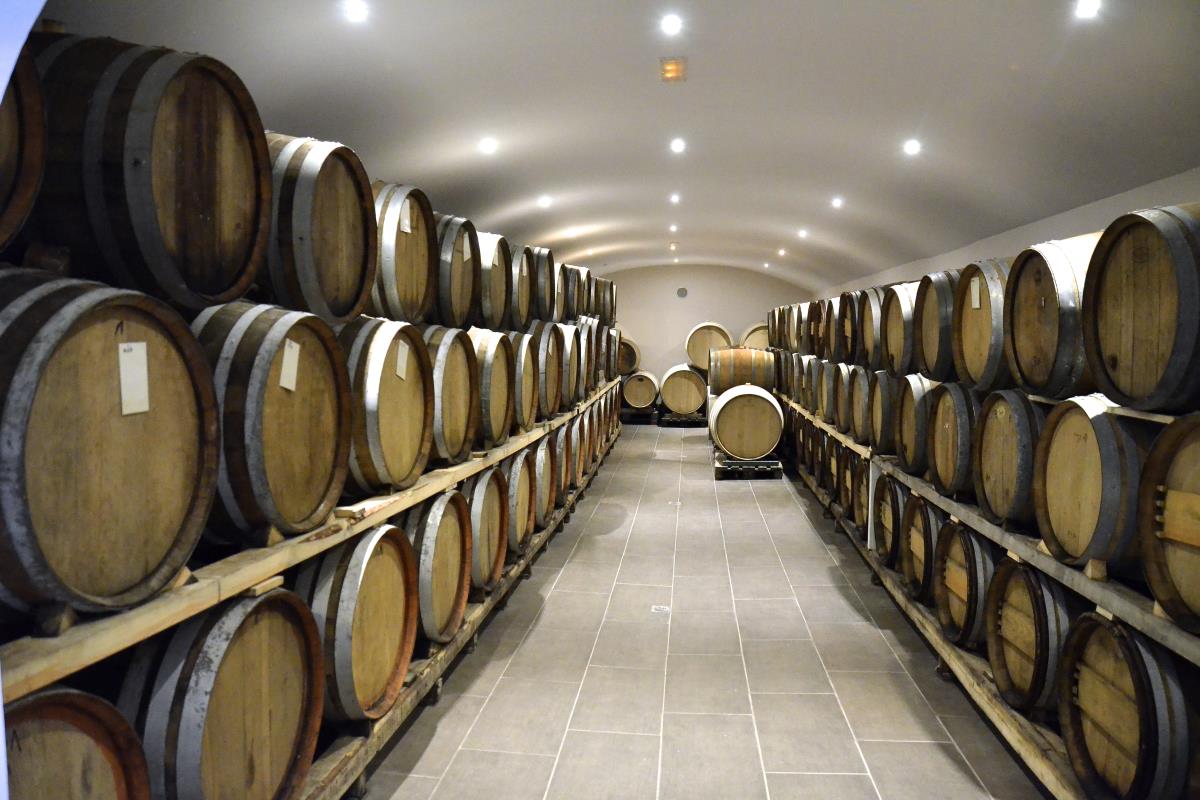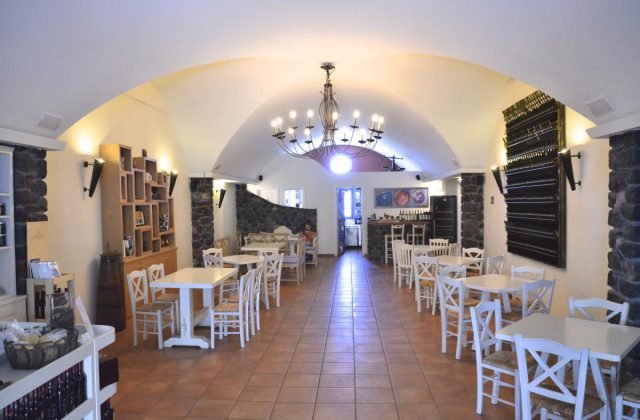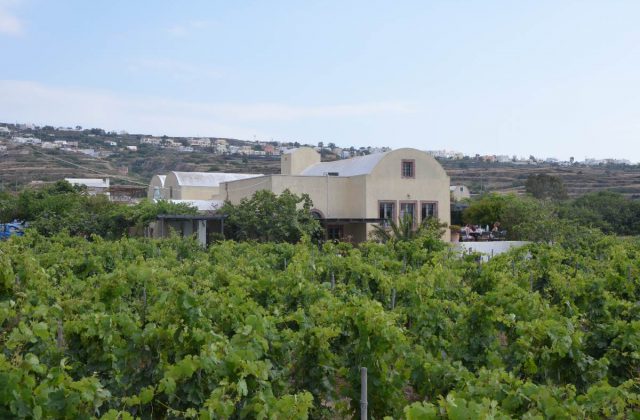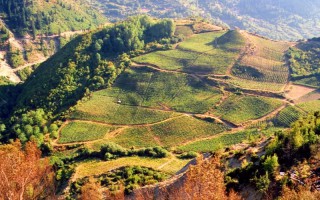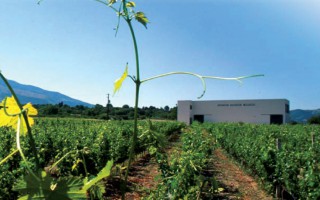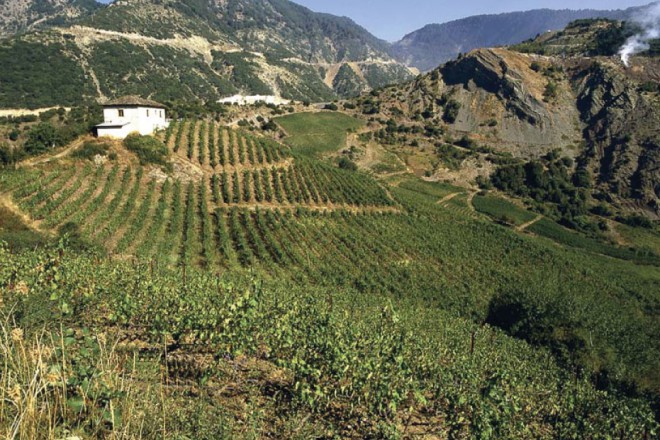The Koutsoyannopoulos Winery on Santorini includes the unique Koutsoyannopoulos Wine Museum. The museum presents the history of wine and the life of the Santorinian vintner from 1660 to 1970 in an old and labyrinthine winery, eight metres below the surface and 300 metres long. Visitors are shown around the history of wine through the use of mobile and still reproductions, while automatic electronic audio guides explain it all in fourteen available languages.
Great care and attention has been taken to show and tell all the stages of wine production along the route in specially decorated kanaves (underground storage rooms). Pruning the vines, ploughing the soil, harvesting the grapes, weighing and pressing the harvest, cleaning the vats, crafting the barrels, distilling the raki, loading the boats for export are all shown, interspersed with old tools, containers and rare machinery.
Μore at Greek Gastronomy Guide…
Source: Greek Gastronomy Guide
The Venetsanos Winery, built in 1949 by the Venetsanos family from Megalochori, was the first industrial winery on Santorini. Giorgos Venetsanos’s family, one of the most prosperous on the island, had left for Cairo, Egypt between the wars and when they returned they bought up large tracts of land, including one in Megalohori, above Athinios bay.
Built on the edge of the caldera, exactly above the Athinios port, the Venetsanos Winery had the quirk that it was designed to take advantage of the law of gravity, compensating for the scarcity of electrical power at the time. Due to the inclination of the soil, it was constructed on four different levels, each devoted to a particular stage of vinification, allowing the wine to flow naturally.
Μore at Greek Gastronomy Guide…
Source: Greek Gastronomy Guide
The story of the Canava Santorini distillery began in 1974 when Evangelos Lygnos commenced producing ouzo and tsikoudia (raki) with tender loving care. Born on the island in 1946, he was taught a recipe for ouzo by an old ouzo producer from Smyrna (now Izmir) in Turkey. Combining the information with the experience he gained working at the Venetsanos winery, he created and launched the first Santorinian ouzo, Canava, in 1976.
Evangelos’s son, Loukas Lygnos, has been carrying on the tradition since 1997. Even as a child, Loukas worked with his father and made his first batch of ouzo at the tender age of eleven. With a life spent in the vineyards, harvesting the crop and distilling the fermented fruit of his labours, Loukas began to accrue knowledge, memories and objects from the past. The result was that he became, apart from a good distiller, a great collector of the tools associated with viniculture and distilling.
Μore at Greek Gastronomy Guide…
Source: Greek Gastronomy Guide
The Artemis Karamolegos Winery ’s roots go back to 1952, when grandfather Artemis cultivated his vines and produced wine for his own family, selling off the surplus to the rest of Santorini and thence to the rest of Greece.
“Since I can remember myself I was following my grandfather around and taking part in the all the activities – planting, pruning, harvesting. Generally, I liked dealing with the land”, Artemis Karamolegos tells us.
He took over from his grandfather and father at the Exo Gonias winery and it is he – young, active and full of passion for his work – who has managed to perform a real miracle since 2004, leading a family business far ahead in a very short time.
Μore at Greek Gastronomy Guide…
Source: Greek Gastronomy Guide
Whoever knows Santorini well, must surely have a great deal of respect for Haridimos Hatzidakis, the pioneering yet humble oenologist who contributed decisively to Boutari’s work when the latter established himself on the island in 1992 and whose choices changed Santorini’s wine scene.
At Boutari’s Winery, Haridimos met Konstandina Chrysou who was also working there. The pair fell in love and decided to develop a vineyard on the road to the monastery of Profitis Elias, which had been abandoned by Konstandina’s parents when they had left for Athens following the earthquake of 1956. Haridimos began replanting and they created a little underground winery in a cave at the bottom of the field. The lovers went to Crete to get married and when Haridimos’s parents tried to offer the traditional gift of gold to the bride, she disarmingly told them that she would prefer a gift of barrels, which were expensive at the time, so that they could begin making wine.
Μore at Greek Gastronomy Guide…
Source: Greek Gastronomy Guide
When Paris Sigalas, a young mathematician who had studied mathematical logic in Paris, France, was setting out to produce his first wine at his father’s estate at Baxedes, Oia, for his own personal enjoyment in 1976, there was little to indicate that in forty years his self-owned facility “Sigalas Winery” would be among the top three wineries in Santorini.
The field of logic may have lost a good university professor but Santorini gained a “perpetually moving and ceaselessly experimenting” vintner, as the island welcomed the “French May of ‘68” into its wine.
Μore at Greek Gastronomy Guide…
Source: Greek Gastronomy Guide
 Travel through some of the most renowned Greek vineyards. Stop at celebrated wineries to sample your favourite wines right where they are produced. Meet the people who make them.
Travel through some of the most renowned Greek vineyards. Stop at celebrated wineries to sample your favourite wines right where they are produced. Meet the people who make them.
Seek out the traditional products of each region’s unique cuisine. You will be happily surprised to find tastes and aromas beautifully attuned to the locale.
Enjoy the natural beauty along the Wine Roads of Northern Greece and explore the history that infuses the entire region, from archaeological sites, churches, monasteries, museums and more to the wineries themselves, which are open to visitors. Discover restaurants, tavernas, hotels, inns, local gourmet workshops and stores stocked with regional culinary specialties.
A trip along the Wine Roads is chock full of great experiences, but it’s also flexible. Design your own itinerary and pace. Savor culture, history and culinary delights anywhere and everywhere along the way.
The Wine Roads are really a series of suggested, select routes for the avid and curious traveler interested in visiting some of the most picturesque and fascinating venues in Europe.
 There are wine roads in almost all wine-producing countries. In Greece, the first organized wine roads were outlined in 1997 by the Wine Producers Association of the Northern Greece Vineyard and given the official name “Wine Roads of Northern Greece.”
There are wine roads in almost all wine-producing countries. In Greece, the first organized wine roads were outlined in 1997 by the Wine Producers Association of the Northern Greece Vineyard and given the official name “Wine Roads of Northern Greece.”
Today, there are 29 members in the Association and 8 routes that cross the whole of Northern Greece, with suggested stops at 32 notable wineries of Thessaly (Rapsani and Krania), Epirus, Macedonia and Thrace. Signage along the roads directs travelers to vineyards, wineries and other points of interest.
The many restaurants, tavernas, inns, hotels, traditional shops and outdoor activities round out the traveler’s experience along the 8 Wine Routes. Each designated venue has been selected based on specific qualitative criteria and is so indicated with a special seal of approval.
Source: www.wineroads.gr
: Visitable Wineries: Remarkable visited sites
![]() The Tempi valley forms the southern natural border for the Wine Roads of Northern Greece. The Wine Route of the Olympian Gods starts here, stopping at the villages of Rapsani and Krania (at the Tempi area).
The Tempi valley forms the southern natural border for the Wine Roads of Northern Greece. The Wine Route of the Olympian Gods starts here, stopping at the villages of Rapsani and Krania (at the Tempi area).

 Following the road to the archeological site of Dion and the settlements of Elatohori and Milia, we find Platamonas, Palaios and Neos Panteleimonas, Leptokaria and Litohoro, starting point for a climb on Greece’s highest mountain.
Following the road to the archeological site of Dion and the settlements of Elatohori and Milia, we find Platamonas, Palaios and Neos Panteleimonas, Leptokaria and Litohoro, starting point for a climb on Greece’s highest mountain.
Notable visited sites:
• The settlement of Rapsani and its’ folklore museum
• Archaeological site of Dion
• Platamon (castle, beaches)
• Traditional settlement of Skotina
• Traditional settlement of Palaios Panteleimonas
• Litohoro-Olympus (shelters-mountaineering tourism)
• Tempi
• Ampelakia
Source: www.wineroads.gr
: Visitable Wineries: Remarkable visited sites
Epirus, found in the north-west corner of Greece, is known mainly for its mountainous areas, picturesque lakes and peaceful gulfs. The largest part of its land is mountainous with wild mountains that seem to touch the sky. Geographically speaking, the Epirus route belongs to the Ioannina prefecture and includes the wine producing regions of Zitsa and Metsovo. The wineries of the Wine Route of Epirus are: Zinos S.A., Estate Glinavos in Zitsa and Katogi & Strofilia S.A. in Metsovo.
 Visitors coming to Metsovo by car go via Grevena or Trikala. Metsovo is a listed traditional village built 1160 metres above sea level and boasts hotel infrastructure and, among other sites, the E. Averoff Art Gallery that exhibits many works of art by distinguished creators. The winery of Katogi & Strofilia S.A., Averoff Estate, is close to the Metsovo village square. The area constitutes a centre for winter tourism, it is ideal for winter skiing and boasts two wonderful slopes. The mountains of Peristeri and the Metsovitikos and Kalaritikos rivers form beautiful mountainous landscapes, while the man-made Aoos lake is another one of the wider region`s gems. From the Aoos canyon, visitors can enjoy the view of the Valia Calda National Park, a protected monument of nature. Also, Metsovo is known for its tradition in stock breeding and the production of quality dairy products.
Visitors coming to Metsovo by car go via Grevena or Trikala. Metsovo is a listed traditional village built 1160 metres above sea level and boasts hotel infrastructure and, among other sites, the E. Averoff Art Gallery that exhibits many works of art by distinguished creators. The winery of Katogi & Strofilia S.A., Averoff Estate, is close to the Metsovo village square. The area constitutes a centre for winter tourism, it is ideal for winter skiing and boasts two wonderful slopes. The mountains of Peristeri and the Metsovitikos and Kalaritikos rivers form beautiful mountainous landscapes, while the man-made Aoos lake is another one of the wider region`s gems. From the Aoos canyon, visitors can enjoy the view of the Valia Calda National Park, a protected monument of nature. Also, Metsovo is known for its tradition in stock breeding and the production of quality dairy products.
Descending west from Metsovo, at a distance of 55 km, the visitor will come across the picturesque city of legends and traditions, the capital of Epirus, Ioannina, which extends to the western shore of the splendid island of Pamvotida. Its focal point is the legendary castle of Ioannina with its two acropoles which gaze at the uniquely beautiful island of Pamvotida, where a notable monastic state with monasteries and hermitages which have survived till today, developed in the late Byzantine period.

North-west of the Ioannina basin, having the Kalamas River on its west, is the Zitsa region. Zitsa was praised in the verses of Lord Byron who lived there, in the famous monastery of the Prophet Elijah. The wider region is famous for its wines. Here one will find the Zinos winery and Estate Glinavos, visiting stops for travellers along the Wine Roads of Epirus.
 The theogefyro, a natural bridge made of rocks in Kalamas is a rare monument of nature, while not far off, is the well-known Pateron Monastery and before that is the Paliouri Monastery, known for its festival.
The theogefyro, a natural bridge made of rocks in Kalamas is a rare monument of nature, while not far off, is the well-known Pateron Monastery and before that is the Paliouri Monastery, known for its festival.
The route goes up towards the Zagori region, to the Vikos – Aoos National Park, the most distinct features of its unique beauty being the Vikos gorge and the natural pools of Papigo, as well as the Drakolimni (Dragon Lake) of Gamila. In the wider region, one will find villages and traditional settlements with guest houses and restaurants.
The last stop along the Wine Route of Epirus is the area of Konitsa that is renowned for its unique natural beauty that can be discerned in the massifs of Grammos, Smolikas, Gamila and in the passing of the Sarantaporos, Aoos and Voidomatis rivers. The area is ideal for alternative forms of tourism (hiking, rafting, kayaking, parachuting, winter skiing in Vassilitsa, etc.).
Other spots along the way:
-The Perama Cave
-The Bizanomahon Monument
-The Pavlos Vrellis Museum of Greek History (waxworks)
-The Tsouka Monastery
-Dodoni
-Kalpaki
-Tzoumerkohorie
Source: www.wineroads.gr
: Visitable Wineries: Remarkable visited sites
![]() The vinicultural route of Naousa is geographically the most central route among the Wine Roads of Northern Greece, because in Naousa there is a significant amount of wineries open to visitors, since from a wine- making point of view – at least as far as the quantity is concerned – it is the most important enological area in Macedonia.
The vinicultural route of Naousa is geographically the most central route among the Wine Roads of Northern Greece, because in Naousa there is a significant amount of wineries open to visitors, since from a wine- making point of view – at least as far as the quantity is concerned – it is the most important enological area in Macedonia.
 Travellers to the Wine Route of Naoussa have a choice among 5 wineries, all definitely worth a visit: Elinos, Boutari Winery, Domaine Foundi, Kir-Yianni Winery and Vaeni Naoussa.
Travellers to the Wine Route of Naoussa have a choice among 5 wineries, all definitely worth a visit: Elinos, Boutari Winery, Domaine Foundi, Kir-Yianni Winery and Vaeni Naoussa.



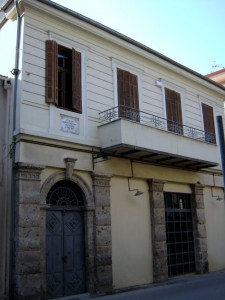 A Museum of Wine and Vine also operates in Naoussa, run by the Municipal Cultural Organisation of Naousa. The museum is based in the renovated I.Boutaris building, a neo-classical building which was built in 1908 by Ioannis Boutaris, as it can be seen on the marble stone at the facade. The building was constructed to be used as the first organised wine factory in Naoussa. The built tank with the bronze gates can still be found on the ground floor. In the Museum there are exhibits presenting the whole process of producing wine traditionally – from the vineyard till its storage in barrels – as well as small objects necessary to the production and consumption process. There is an indicative display of buckets, patokades, a wine-press, vaenia, 500-pound bombs, barrels, tsipouro vases, sprinklers and sulphurators which are placed on the back, pruning-knives, wooden and iron taps, flagons, funnels, bottles made of glass, caps – corks, corkscrews – drills, jugs and decanters, wine glasses etc. Thanks to the Museum of Wine and Vine, one more element is added to the polymorphic local puzzle, enriching the wine-related tourism infrastructure of the area.
A Museum of Wine and Vine also operates in Naoussa, run by the Municipal Cultural Organisation of Naousa. The museum is based in the renovated I.Boutaris building, a neo-classical building which was built in 1908 by Ioannis Boutaris, as it can be seen on the marble stone at the facade. The building was constructed to be used as the first organised wine factory in Naoussa. The built tank with the bronze gates can still be found on the ground floor. In the Museum there are exhibits presenting the whole process of producing wine traditionally – from the vineyard till its storage in barrels – as well as small objects necessary to the production and consumption process. There is an indicative display of buckets, patokades, a wine-press, vaenia, 500-pound bombs, barrels, tsipouro vases, sprinklers and sulphurators which are placed on the back, pruning-knives, wooden and iron taps, flagons, funnels, bottles made of glass, caps – corks, corkscrews – drills, jugs and decanters, wine glasses etc. Thanks to the Museum of Wine and Vine, one more element is added to the polymorphic local puzzle, enriching the wine-related tourism infrastructure of the area.
A tour of the wineries can be complemented by a visit to various places of archaeological and touristic interest such as:
– Vergina, the Macedonian Kings’ Tombs
– Veroia (Byzantine and Laterbyzantine Temples, Archaeological Museum)
– The Macedonian Tombs of Leykades in Naousa
– Nymfaion of Mieza, right outside Naousa (the School of Aristotle)
– Skiing Resort 3- 5 Pigadia
– Skiing Resort Seli
– Arapitsa
– St. Nikolaos in Naousa
– Vergina, the Macedonian Kings’ Tombs
– Veroia (Byzantine and Laterbyzantine Temples, Archaeological Museum)
– The Macedonian Tombs of Leykades in Naousa
– Nymfaion of Mieza, right outside Naousa (the School of Aristotle)
– Skiing Resort 3- 5 Pigadia
– Skiing Resort Seli
– Arapitsa
– St. Nikolaos in Naousa
Finally, visitors can enjoy excellent restaurants, tavernas, local product shops and outdoor activities, all of which are accredited members of the Wine Roads network.
Source: www.wineroads.gr
: Visitable Wineries: Remarkable visited sites

